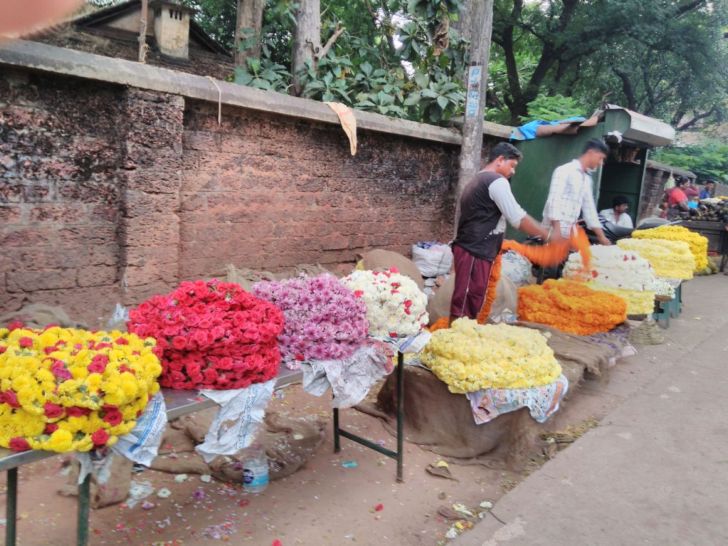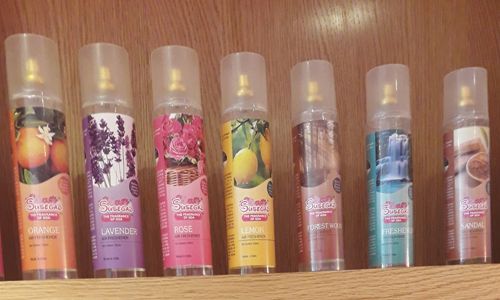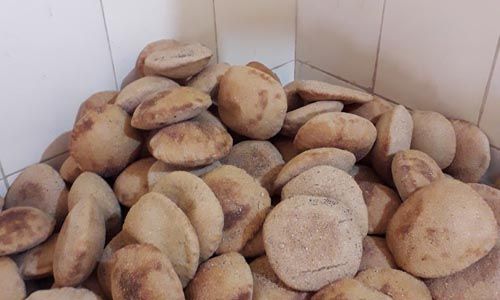Mangalore is still small town enough to wear its old fashioned politeness on the sleeve even on the road.No take it or leave it attitude, no aggressive, loud voice, not even a passive-aggressive comment, but plain “I am here to help you and that is what I am going to do.†Was that just a fluke and was that girl just having a great day? Apparently not, these were just small town courtesies during our stay.
March 25, 2019
Mangalore
By Pushpa Iyengar,
Goa seems more geared to tourists in terms of what shops showcase, and therefore liquor, cashew nuts, bebinca and Goa sausages are in profusion and well displayed in most shops, but Goans who live here are definitely not spoilt for choice whether it comes to fruits and vegetables or masalas. Mangalore, about 380 kms away, is therefore a revelation, because shops there stock what locals need and want in generous measure. You ARE spoilt for choice there.
Even a shop that is not fancy and tiny could unravel things you have not seen before. Take for instance Konkan Traders, a small shop opposite the Milagres Church, a landmark in Mangalore. Your head would reel at the stuff they have. Looking for masala? There’s Coorg masala (which is pepper heavy and meant for the Coorgi pandi curry but you can improvise), of course the ubiquitous Bafat masala (Mangalore’s version of a garam masala which is available widely), the stew masala (yes, Goans, if you want to make stew and don’t want to spend too much time slaving over a hot stove, definitely get a packet of this) and there’s ghee roast. Now in Mangalore, the ghee roast masala is extremely popular and versatile, whether you are eating fish/chicken or sweet corn. With its profusion of flavours and tempered with ghee that adds its own flavour, ghee roast will definitely come in handy when you are too lazy and still want to make something tasty but not elaborate.
Variety is the spice of life
This little shop has jars of pickles not just the traditional ones. So, how about Mixed Vegetable pickle that has carrot, papaya, dates apart from spices? How about slivers of pickled mangoes and carrots in a bottle?
Then there is the ginger preserve, which is basically ginger boiled in sugar syrup, but this makes the difference between an ice-cream and to-die-for ice-cream! We can vouch for this because the owner of Summer Sands, a lovely resort plum bang on the beach in Ullal about 12 kms outside Mangalore , whose guests we were for lunch last October, ordered this for desert. We overcame our protestations about being too full after the meal, once we had our first mouthful. Believe me, you will be asking for seconds.
There were places where you could pick up a packet of neer dosai or appams, pooris or chapathis to go or just stop in at a small eatery for steaming mangalore bajes. What is also comforting are the low prices you pay that offers the indulgence to clean up the shelf of its goodies. The prices of anything is about two-thirds what you would pay in Goa, and the huge advantage is the variety.
An old-fashioned courtesy During our month’s stay in Mangalore, and living life like the locals do, we even got to thinking that it would not be half-bad to relocate because life seemed so easy and uncomplicated. It’s a small town when it comes to small courtesies in your interface whether it is in the shops or surrounded by traffic on the road or queueing up to pay an electricity bill, and yet a big town when it comes to living life King size.
During our month’s stay in Mangalore, and living life like the locals do, we even got to thinking that it would not be half-bad to relocate because life seemed so easy and uncomplicated. It’s a small town when it comes to small courtesies in your interface whether it is in the shops or surrounded by traffic on the road or queueing up to pay an electricity bill, and yet a big town when it comes to living life King size.
Going to MESCOM, to enquire about an electricity bill for an apartment we had rented in Bejai on (Bejai Main road), was a pleasant experience. No take it or leave it attitude, no aggressive, loud voice, not even a passive-aggressive comment, but plain “I am here to help you and that is what I am going to do.” Was that just a fluke and was that girl just having a great day? Apparently not, these were just small town courtesies during our stay.
While Goa, because of its tourists renting two-wheelers and zipping around has become a far cry from the civility you took for granted on Goa’s narrow roads 20 years ago, Mangalore is still small town enough to wear its old fashioned politeness on the sleeve even on the road. I remember an incident when we were trying to park opposite a shop, but the space was a bit of a crunch because there was a two-wheeler. But the owner of the vehicle shot out the shop like a bullet from a gun, apologized profusely and quickly made space. Wow! No blood-letting, no flipping of fingers or any other vulgar gesture, no hot words exchanged!
Then there was this other incident, when this time a friend and I were parked behind a couple who had gone to lunch. After waiting a bit, my friend took off to bring her takeout order herself. But apparently, it was not ready and so she chose to wait. Meanwhile, the couple came out of the restaurant having finished their lunch and I was in a tizzy because my friend, the driver, was not there. I imagined this couple raining down curses for blocking them. But no drama whatever, not even a killer glance! They got into the car, carefully maneouvred past our car while backing it out, smiled at me and were on their way. Huh? What just happened?
They love to eat
Driving around, we were totally awed by the neon lights on the road and the first observation that stuck was that Mangalore is quite a foodie’s paradise. For a relatively small city, it was studded with eating places, from humble wayside fish curry/chicken kabab joints and places where you can buy a serving of sambar for just Rs 10, to slightly fancy Udipi places serving neer dosai/vegetable stew and fine dining restaurants, even liquid lounges.
The thing is all eating places are geared for residents and their wallets. So if its goli baje you want you can pick a modest eatery, if it’s a fish thali you can get the basic one for Rs 50 which will have xit-kodi, except it will not include the mackerels/pomfrets/kingfish which is the reason you went dining in the first place. And like in Goa, you do not pay an arm and a leg if you order any of those dishes.
But tourism could get a leg up
While Udupi, an hour away along the highway, is overrun with tourists, mostly pilgrims to see the Krishna temple, Mangalore with its Sulthan Bathery and its beaches and Bandar (the wholesale market area next to the sea) is not such a big draw except for locals who take in the beaches on a Sunday. In this sense, Goa steals a march with its myriad beaches, its paddy fields and its swaying palm trees, its rains that give it a washed, clean and green look and its temples and churches.
But tourists and locals do flock to the St Aloysius Chapel which was opened in 1878. Incidentally you do not have to go to Rome to feast your eyes on the Sistine Chapel because the splendour and beauty of that iconic church can be seen at the St Aloysius Chapel.
The main building of St Aloysius college with the chapel at the southern end was built in 1880. The chapel was painted by the world-renowned Italian Jesuit artist, Brother Antonio Moscheni between March 1899 and August 1901. The paintings depict the life of St Aloysius Gonzaga, the patron of the college, on its main ceiling, the apostles on the sloping ceiling, saints of the church on the arches and the life of Jesus on the walls, the pillars and on the ceiling of the aisles. In total the paintings cover 829 square metres.
Incidentally, St. Aloysius was the eldest son and heir of the Marquis of Castiglione in Italy who gave it all up for service to God. There is a guide here who takes you around pointing out the exquisite frescoes and paintings, telling you stories and cross-questioning you (if you a good Catholic you will know the answers!) on the events in the Bibles that stare down at you as you saunter around.
The paintings are frescoes and canvases that over the years have gathered dust and pollution. They got an extreme makeover by the INTAC Conservation Institute (INTACH- ICI) and were rededicated on February 16 (year?) after 18 months of work that cost Rs 1.5 crores. Interestingly, Silvana Rizzi, great grandniece of Antonio Moscheni, was present at the re-dedication.
According to Nilabh Sinha, Principal Director, INTACH Conservation Institutes (ICI), Art & Material Heritage Division, New Delhi, all the paintings were badly damaged by rain water seeping through the walls, dust and fungal growth. The paintings were restored by specialists from INTACH-ICI, Lucknow from 1991 to 1994 under the supervision of Dr Agarwal, the then Director. He advised that the paintings should be examined every 20 years. And that’s how the painstaking restoration began in November 2017 and ended this year.
Food for thought And after a feast for the eyes, a feast for the palate seems to be in order and for that you cannot get better than Pabbas (M G Road, Lal Bagh), the ice-cream parlour, that is cool (literally) and unique because it’s hard to imagine that a sprawling “restaurant” has only ice-creams on the menu. It’s patronized by kids, hip college kids, the middle-aged, the aged. Irrespective of their age, all customers turn into greedy kids when they see the expansive menu, because – yes, you guessed it, you are spoiled for choice.
And after a feast for the eyes, a feast for the palate seems to be in order and for that you cannot get better than Pabbas (M G Road, Lal Bagh), the ice-cream parlour, that is cool (literally) and unique because it’s hard to imagine that a sprawling “restaurant” has only ice-creams on the menu. It’s patronized by kids, hip college kids, the middle-aged, the aged. Irrespective of their age, all customers turn into greedy kids when they see the expansive menu, because – yes, you guessed it, you are spoiled for choice.
And do you pay an arm and a leg which you pay for ice-creams in Candolim where servings are big only if one were to look under the microscope? The answer in one word is NO. Here for Rs 100, you will get a big falooda - a glassful of ice-cream, nuts, sprinkles, whatever (depending on what you order) and you can easily skip dinner not just because of those gazillion calories but also because the portions are huge.
Perhaps not unlike Mangalore where huge dollops of goodness seem to be dished out!



